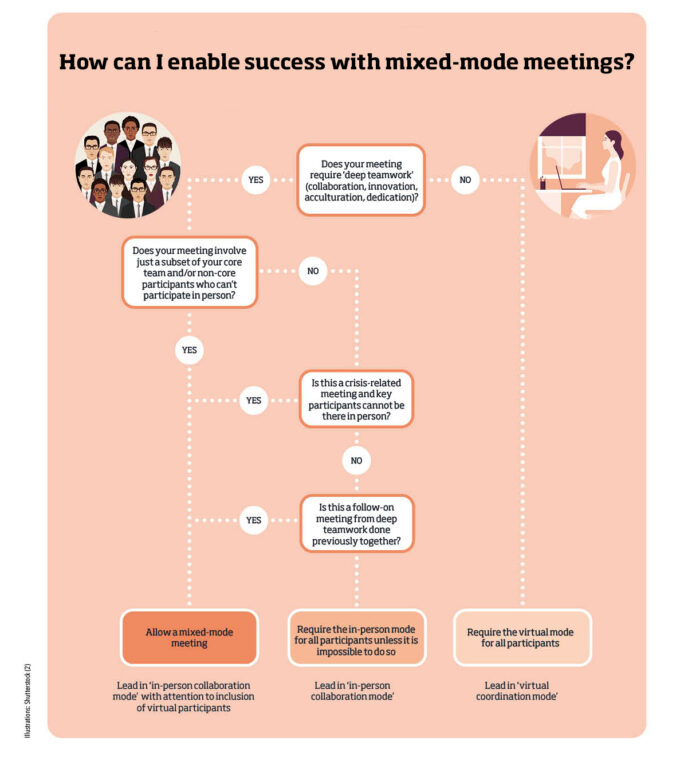
Three ways to deal with the almighty boss
What to do when those in positions of authority behave in ways that contradict widely accepted norms of civility, empathy, and ethical leadership....
Audio available

by Robert Hooijberg, Michael D. Watkins Published September 17, 2021 in Human Resources • 2 min read
Much of the conversation about hybrid work focuses on striking the right balance between the in-person and virtual modes. And we, too, have begun to explore the differences in how leaders need to support teamwork in the in-person and virtual modes. However, it’s increasingly clear that there is a third option – mixed-mode meetings – that presents additional challenges.
By mixed-mode, we mean meetings in which some participants are together physically while others are virtual. How should leaders balance the potential benefits of having some people present in person against the potential costs of diminished inclusion, connection, and influence for the virtual team members?
We started with the principle that mixed-mode meetings should happen only when they create concrete business value, and when it’s really not possible for the team to be together fully.
Here is our guide to how to decide whether and when to allow mixed mode meetings. This chart will help you decide when to schedule a meeting in person, when a Zoom meeting will suffice, and how to help people collaborate in hybrid gatherings.


Professor of Organizational Behaviour at IMD
Robert Hooijberg is Professor of Organizational Behavior at IMD. His areas of special interest are leadership, negotiations, team building, digital transformation, and organizational culture. Before joining IMD in September 2000, Professor Hooijberg taught at Rutgers University in their MBA and Executive MBA programs in New Jersey, Singapore, and Beijing. He is Program Director of the Breakthrough Program for Senior Executives and the Negotiating for Value Creation course.

Professor of Leadership and Organizational Change at IMD
Michael D Watkins is Professor of Leadership and Organizational Change at IMD, and author of The First 90 Days, Master Your Next Move, Predictable Surprises, and 12 other books on leadership and negotiation. His book, The Six Disciplines of Strategic Thinking, explores how executives can learn to think strategically and lead their organizations into the future. A Thinkers 50-ranked management influencer and recognized expert in his field, his work features in HBR Guides and HBR’s 10 Must Reads on leadership, teams, strategic initiatives, and new managers. Over the past 20 years, he has used his First 90 Days® methodology to help leaders make successful transitions, both in his teaching at IMD, INSEAD, and Harvard Business School, where he gained his PhD in decision sciences, as well as through his private consultancy practice Genesis Advisers. At IMD, he directs the First 90 Days open program for leaders taking on challenging new roles and co-directs the Transition to Business Leadership (TBL) executive program for future enterprise leaders, as well as the Program for Executive Development.

March 14, 2025 • by Merete Wedell-Wedellsborg in Human Resources
What to do when those in positions of authority behave in ways that contradict widely accepted norms of civility, empathy, and ethical leadership....
 Audio available
Audio available
March 4, 2025 • by Ginka Toegel in Human Resources
Current and aspiring women leaders may be self-conscious about their appearance, but strategies for developing an authentic professional style can redirect attention to their achievements, as they dress for comfort and confidence....

February 20, 2025 • by Katharina Lange in Human Resources
Understanding generational differences is crucial to unlocking potential, retaining talent, and becoming a more effective leader....
 Audio available
Audio available
January 27, 2025 • by Didier Bonnet in Human Resources
No one expects CHROs to become technical experts, but with a firm grasp of the fundamentals they can help shape an intelligent approach to AI adoption...